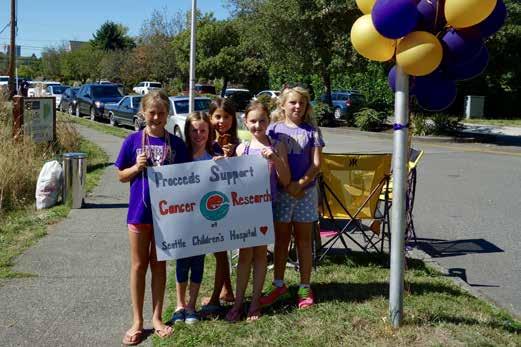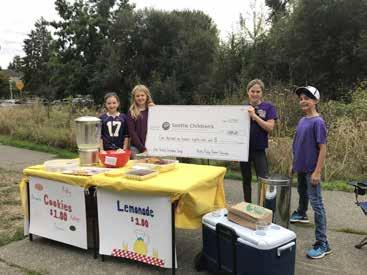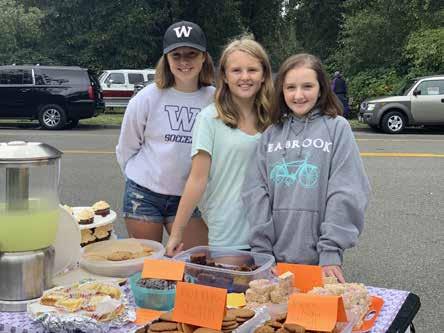
4 minute read
COOKIES FOR CANCER! R a i s i n g A w a r e n e s s T o S u p p o r t

Pediatric Cancer Research
Advertisement
Written by Jen Belle
Every September, four young school friends hold a lemonade stand near the UW Center for Urban Horticulture in Laurelhurst. For three hours on the afternoon of the first home Husky football game, the girls holler “Cookies for Cancer!” and tempt fans on their way to the stadium with Rice Krispy treats, chocolate chip cookies, and lemonade. They have held this event for seven years running, ever since they were adorable first graders who could not even make change. One among them is a cancer survivor – my daughter, Katie, now 14. While these girls could undoubtedly find ways to spend their haul on cute earrings, they donate every dollar to fund pediatric cancer research at Seattle Children’s. And it might surprise you to know how much those dollars really count. At the age of 3 ½, Katie was diagnosed with an aggressive form of cancer that occurs only in children. Stage four high-risk neuroblastoma is exceedingly difficult to treat. At the time of her diagnosis, Katie’s doctors estimated that she had a 1 in 3 chance of surviving to celebrate her 8th birthday. Our family was devastated. Her doctors were hopeful that the experimental treatments being tested in two clinical trials would give kids like Katie a better chance. We enrolled her in both trials and crossed our fingers. Katie’s treatment took about a year and a half. She had six rounds of chemotherapy, two rounds of high-dose chemotherapy followed by stem-cell transplants, 14 doses of radiation, and 5 months of antibody therapy. All of these treatments were very hard on her little body. She lost all her hair, threw up incessantly, and felt weak and tired most days. Katie had more than one life-threatening bloodstream infection. She couldn’t go to school or spend time with friends, as preschool kids are undoubtedly little germ carriers. When Katie got a cold, her body didn’t have what it needed to fight the infection, so the colds often turned into pneumonia. She spent about 200 nights at Seattle Children’s, including 10 days in the ICU. Six months after finishing treatment, Katie’s scans showed no evidence of disease, and she has been incredibly fortunate to remain cancer-free for nine years.
Katie survived her cancer, and as it turned out, the combination

of the two clinical trials in which she participated proved to be

amazingly effective, raising the survival rate for kids with her diagnosis to about fifty percent. Still, there is a long way to go for the kids who have come after her, and there is a lot of research yet to be done before neuroblastoma is considered an easily cured disease. The treatment Katie received has caused numerous lifelong health complications, including permanent hearing loss, a damaged thyroid gland, and a broken pituitary gland. Katie is not alone – over two-thirds of childhood cancer survivors experience serious or life-threatening side effects from their treatment. Researchers are not satisfied with survival rates, nor the side effects of today’s treatments for their patients, so they continue searching for a better path.
Where does Seattle Children’s get the money to fund pediatric cancer research? Not until my own daughter was diagnosed with cancer did I understand how inadequate funding sources are. Doctors can’t just deploy the drugs used to treat adult cancers because kids don’t get the same types, and their bodies respond differently to treatments. There are hundreds of types of pediatric cancer that each need to be researched, and thousands of potential treatments to explore. Across all types, about 15,000 kids are diagnosed with cancer in the U.S. each year and about 3,000 kids with the most common type (acute lymphocytic leukemia) and fewer than 10 with the rarest cancers. The small patient population size has huge implications. Pharmaceutical companies cannot justify researching pediatric cancers because there are not enough patients to turn a profit. Children’s hospitals and the universities they are affiliated with do the vast majority of the research. Their primary funding source is the U.S. government. Yet the National Cancer Institute allocates a mere 4% of its total cancer research funding to pediatric cancer, which amounts to a tiny fraction of what is needed to study each disease.
Doctors like Katie’s rely on donations from the family and friends of patients to help cover research costs. Annually, hundreds of millions of dollars are raised for research by private foundations, many of which were started by the parents of children who have died, and those like us who got lucky on the coin flip. Every dollar counts. In fact, because they have such a hard time finding enough money for all of the research they want to do, pediatric oncologists from many hospitals work together to find better cures, which is something not done in adult cancer research.
Katie and her friends have raised $4,200 at their lemonade stand. Including matches from family and friends, they have funded $8,500 of scientific research taking place at Seattle Children’s Hospital Research Institute, the 5th largest pediatric research center in the U.S. One of Seattle Children’s top research goals is finding more effective treatments for childhood cancer that are safer for kids’ growing bodies. We offer a moment of thanks every day to Seattle Children’s for working hard to save our daughter’s life.
Katie and her friends are raising money to help find better cures for neuroblastoma. They want to save the lives of more kids while helping doctors find treatments that are less severe on young bodies. Their goal is to help all kids grow up with normal, healthy bodies and live to be little old ladies and little old men.
Would you like to join them?
https://giveto.seattlechildrens.org/KatieBelleFund


